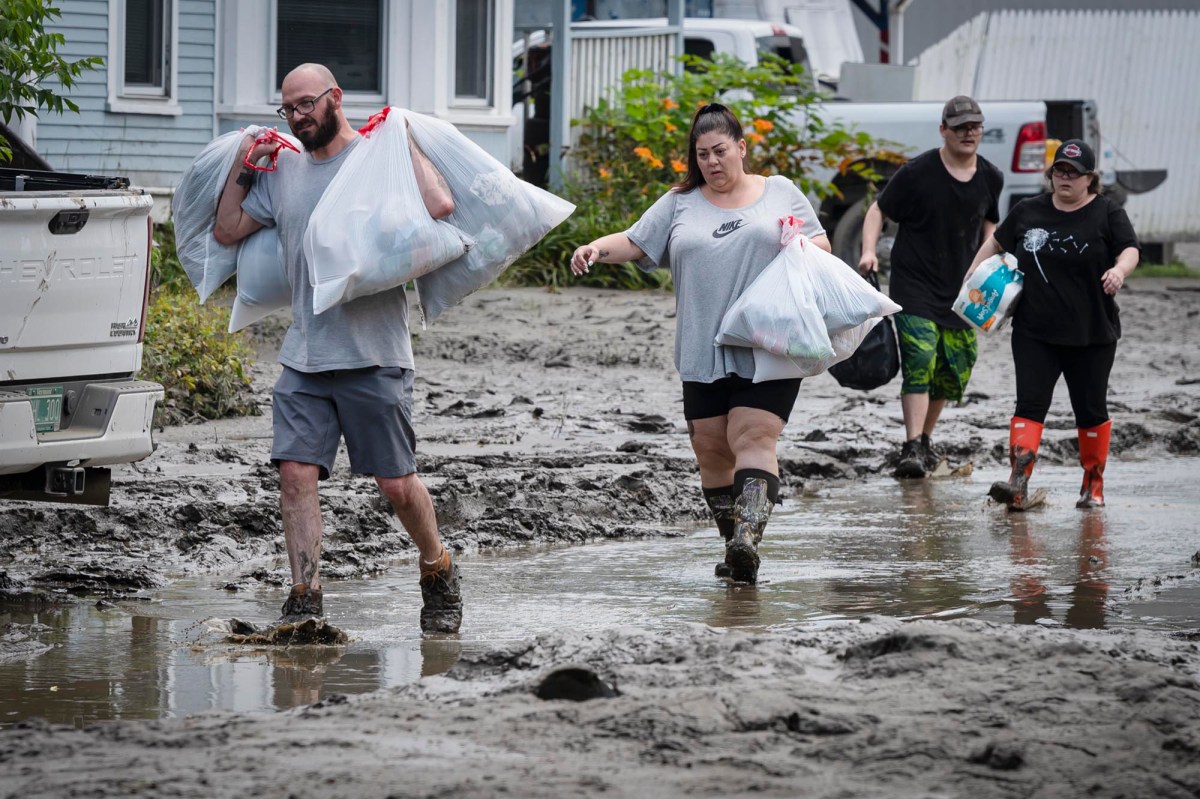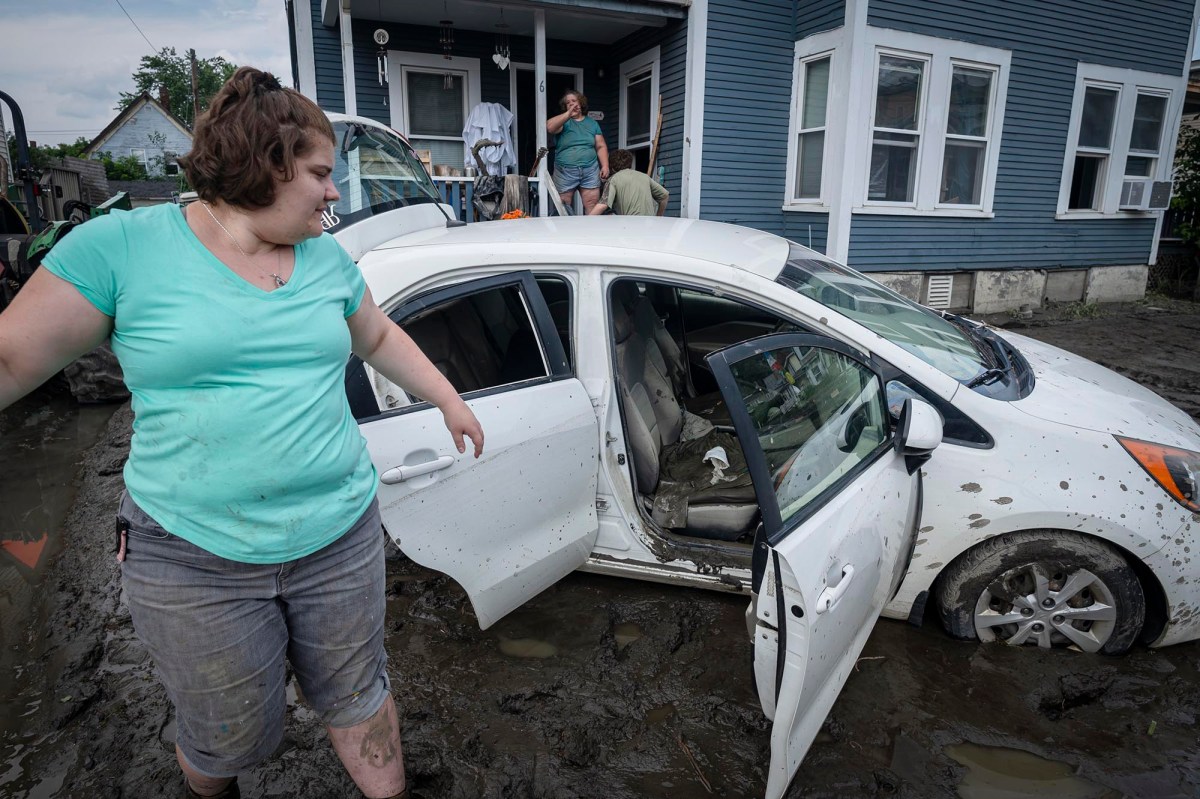
BARRE CITY — Walking through the northern portion of this flooded city on Wednesday, the odors morphed every few blocks. On Maple Avenue, the stench was overwhelmingly fishy. On Second Street, musty. On Main Street, sour.
On First Street, wading between two of his apartment buildings, local landlord Tim Jarvis grimaced. “Kind of a dead mouse smell,” he mused.
Consistent throughout the residential neighborhood, though, was the thick mud left behind by floodwaters that swept through the city on Monday as record-setting rain hammered the state. Step where it was several feet deep, and risk sinking into the goop as if it were cartoon quicksand.
Jess Bernier, a tenant of Jarvis’s, stood on the side porch of her building. It was as far as she planned to go outside until the mud, which came up to the porch’s top two steps, was cleared.

Bernier’s second-floor apartment stands high above where floodwaters crested Monday night, but she didn’t fully escape this week’s natural disaster. The water in the basement of her building — which housed her apartment’s hot water heater — remained roughly four feet deep by Wednesday afternoon. Jarvis apologized to Bernier profusely; it would be a while before the basement would be dry enough to install a new hot water heater.
Thankful her home was still standing, Bernier smiled and said, “I’m not complaining.” She wore a T-shirt which read, “Stay grateful.”
“I think we have a lot to be grateful for. And the feds are going to pay for new roads,” she quipped, gesturing at Main Street, which had been pocked with potholes long before the floods.

The feds did, in fact, visit Bernier’s neighborhood on Wednesday afternoon to assess the damage in Washington County’s largest city. The neighbor to the capital is home to some 8,400 residents, a quarter of whom live in poverty, according to federal data, compared to a tenth statewide.
As construction equipment cleared mud from driveways and sump pumps pushed water from basements into the streets, Vermont’s congressional delegation and representatives of the Federal Emergency Management Agency, or FEMA, trudged along.
They were joined by Gov. Phil Scott and Barre City Mayor Jake Hemmerick, who has been traversing the city surveying damage from his mountain bike.
One day earlier, President Joe Biden approved a federal disaster declaration to the state, authorizing FEMA to mobilize and begin providing Vermont equipment and resources to aid recovery. Under the declaration, the feds will pay for 75% of emergency protective measures provided by the agency.
For several residents on Second Street, the officials’ visit was welcome. They took a break from cleanup to shake hands and say thank you. FEMA’s logo, instantly recognizable, was their sign that help was on the way. (As was Vermont’s famed independent senator, Bernie Sanders, in the eyes of one resident who ran to him exclaiming, “Holy shit, it’s him!” They embraced and she began crying.)

Earlier on Wednesday, FEMA Administrator Deanne Criswell, Scott and other officials had boarded a helicopter to survey the damage from above. Her feet back in the mud on Second Street, Criswell told VTDigger that the aerial view let her see how widespread the damage is, but “it doesn’t replace being on the ground.”
She had traveled to the state in the morning from Washington, D.C.
“Standing right here, talking to the families that have been impacted — this is why I came,” she said. “This is why I came, to be able to assess firsthand, see firsthand, truly what the impacts are so we know what kind of resources we need to help bring in to help support and start this recovery process.”



FEMA’s regional administrator for New England, Lori Ehrlich, said that the agency is also monitoring nearby states, particularly western Massachusetts and New Hampshire. As of Wednesday, though, damage there paled in comparison to Vermont.
“Storms don’t know state borders, but this one really did seem to target Vermont,” Ehrlich said. “It was almost completely contained in the borders of Vermont, the worst of it.”
Sanders observed the street around him on Wednesday and called it “really quite an incredible sight. I’ve never seen a street filled with mud in the way that this is.”

As the state inches toward recovery — and as natural disasters nationwide become more frequent and more fierce as the climate warms — socioeconomic equity remained top of mind for Vermont’s senior U.S. senator.
“Working-class people, lower-income people, are really going to be hurt by this,” Sanders told VTDigger. “The wealthy have resources to protect themselves that ordinary people don’t.”
U.S. Rep. Becca Balint, D-Vt., struck a similar note when speaking to VTDigger after the tour — her first through a disaster in the state since her election last fall. Vermont’s housing crisis, which long predates the flood, only exacerbates the emergency, she said.
“Certainly, this is one of those areas that was already struggling in many ways before this terrible flood, and now, you’ve got even more people who don’t have housing,” Balint said. “So one of the conversations I just had with the FEMA administrator is that we’re going to need as many tools, specifically around housing, as we can get. I wanted to put that front and center on her radar screen.”




Balint gestured up the hill toward Barre Auditorium, out of which the Red Cross was sheltering 58 Vermonters as of Wednesday morning, according to the governor’s office.
“We’ve got a very full shelter here right now in Barre and as we all know, a shelter is just that — a shelter — not a home. It’s not a permanent spot,” Balint said. “So I’m very concerned about making sure this (federal) money gets out quickly.”
The basements and first floors of Jarvis’s downtown apartment buildings were wiped out by flooding. One unoccupied first-floor apartment had been set to receive a new tenant shortly, as part of a local transitional housing effort for Vermonters experiencing homelessness. Careful not to slip on the muddy tiled floor walking through the apartment on Wednesday, Jarvis pointed to a dark, knee-high line of sediment on the wall marked where the waters crested. No one will be able to move in anytime soon.

Jarvis questioned if his buildings would be structurally sound after flood waters crashed through the basement windows, carving gaping caverns along their foundations. Who does he call to request a building inspection? How long will it take for them to come? He asked these rhetorical questions aloud.
In a state with single-digit rental vacancy rates before the flood, Jarvis said he has no idea where would-be tenants will go in the meantime.
“We’re not going to have these things ready for, honestly, months,” he said.
